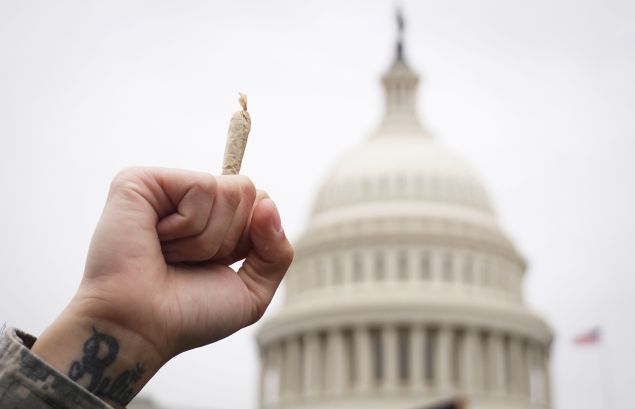 A pro-cannabis activist holding up a joint during a rally on Capitol Hill. Photo: Mandel Ngan, AFP
A pro-cannabis activist holding up a joint during a rally on Capitol Hill. Photo: Mandel Ngan, AFP Cannabis is becoming recreationally or medically legal in a growing number of states in the United States, as neighboring countries like Canada and Mexico have either legalized the drug or are well on their way to doing so.
As it enters the mainstream, more people are using cannabis than ever before. But the shift poses a serious challenge to law enforcement officials tasked with deterring drugged driving.
DUI arrests are commonplace in the U.S. In 2016 alone, more than 1 million people were arrested for driving under the influence of drugs or alcohol in the U.S. according to the Center for Disease Control.
As more states have legalized cannabis and the drug has become more accessible, more Americans say they are using cannabis on a daily basis.
At the same time, more Americans report driving while under the influence of marijuana, and law enforcement officials in states like California which have legalized the drug, are seeking new ways to test for its presence.Jennifer Harmon is the director of the San Diego Sheriff Department’s Crime Lab and told The Globe Post that while law enforcement in California has been working to understand cannabis impairment since the state made cannabis medically legal in 1996, there is still more work to be done.
“We do expect with increased access, we’re going to have increased use,” Harmon said. “There is additional work that’s being done to train more officers, to train more teachers, to improve the testing capabilities of the laboratories, and to ensure that they have the ability to test for cannabinoids.”
The challenge for law enforcement is that testing for Cannabis impairment or the presence of the drug in a person’s body is not as simple as it is with alcohol.Part of the problem is the standard field sobriety tests and breathalyzers police use to test the blood alcohol levels and alcohol impairment of drivers don’t necessarily work for detecting cannabis impairment.
When forensic toxicologists test for traces of cannabis in samples of blood, urine, or saliva, there are two different compounds they look for. The first is delta-9 THC – the psychoactive compound in cannabis that only remains in the body for a short time after initial cannabis use.
If tests find delta-9 THC in blood or saliva samples, it indicates someone may be impaired. The other is carboxy THC, which can remain in fluid samples long after the initial use of cannabis and is especially prevalent in regular users.
The results of tests can differ substantially depending on which fluids are tested. Urine samples only yield carboxy THC and saliva samples only yield delta-9 THC while blood samples can yield both.
“Say you use several times a day, several days in a row, and then you stop. While the delta-9 goes away pretty quickly, that carboxy metabolite can stay there for quite some time, but it’s not impairing,” Amy Miles, the forensic toxicology section director at the University of Wisconson told The Globe Post.
“There’s usually a time delay from when the stop or the crash occurs and when the blood is drawn,” Miles said. “The number we get is not representative of what the person was when they were driving.”
Because delta-9 levels decline so quickly, another challenge for law enforcement is the time delay between pulling over a suspected impaired driver and actually testing their blood or oral fluid quickly enough to detect the compound.
One problem that cannabis shares with alcohol in determining impairment is the level of tolerance an individual might have depending on how regularly they drink or smoke. A person who smokes every day won’t be as impaired as someone who smokes only once every 6 months, and the same holds true for alcohol.
While there is a standardized federal blood alcohol level for legal impairment (the federal standard of a 0.08 blood alcohol level for legal impairment is known as a “per se law”), Cannabis does not yet have any per se laws in place in most states, and impairment is often determined in large part by the officer who pulls over the driver in question.
“The impairment can be all over the place for somebody at eight nanograms and then somebody else at eight nanograms can show less impairment,” Miles said. “While we can do the testing and tell you how much is there, we can’t really say at this nanogram level we know people are impaired because it’s so dependent on the person.”
Robert Solomon, a law professor at the University of Western Ontario in Canada, where the government passed a per se law for cannabis impairment last year, told The Globe Post the law was necessary to create a “bright-line indicator” for law enforcement.
“If you have more than two nanograms of THC in your blood, regardless of how you’re driving, that’s a federal criminal offense,” Solomon said. “If you drive at 110 kilometers an hour (68 MPH) …and you are a fabulous driver and I am a crappy driver, the fact that you’re a better driver in violation of the law doesn’t matter because we need a bright line indicator looking at it.”

No comments:
Post a Comment